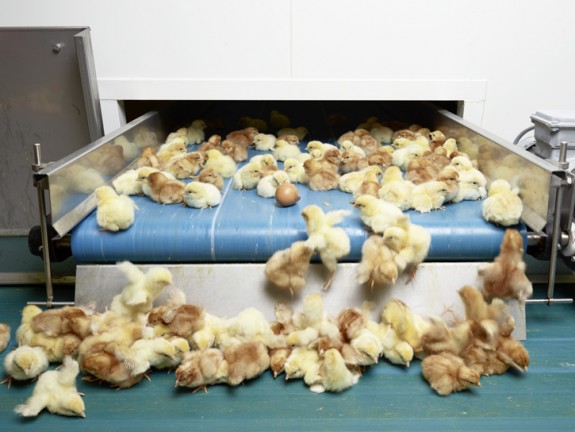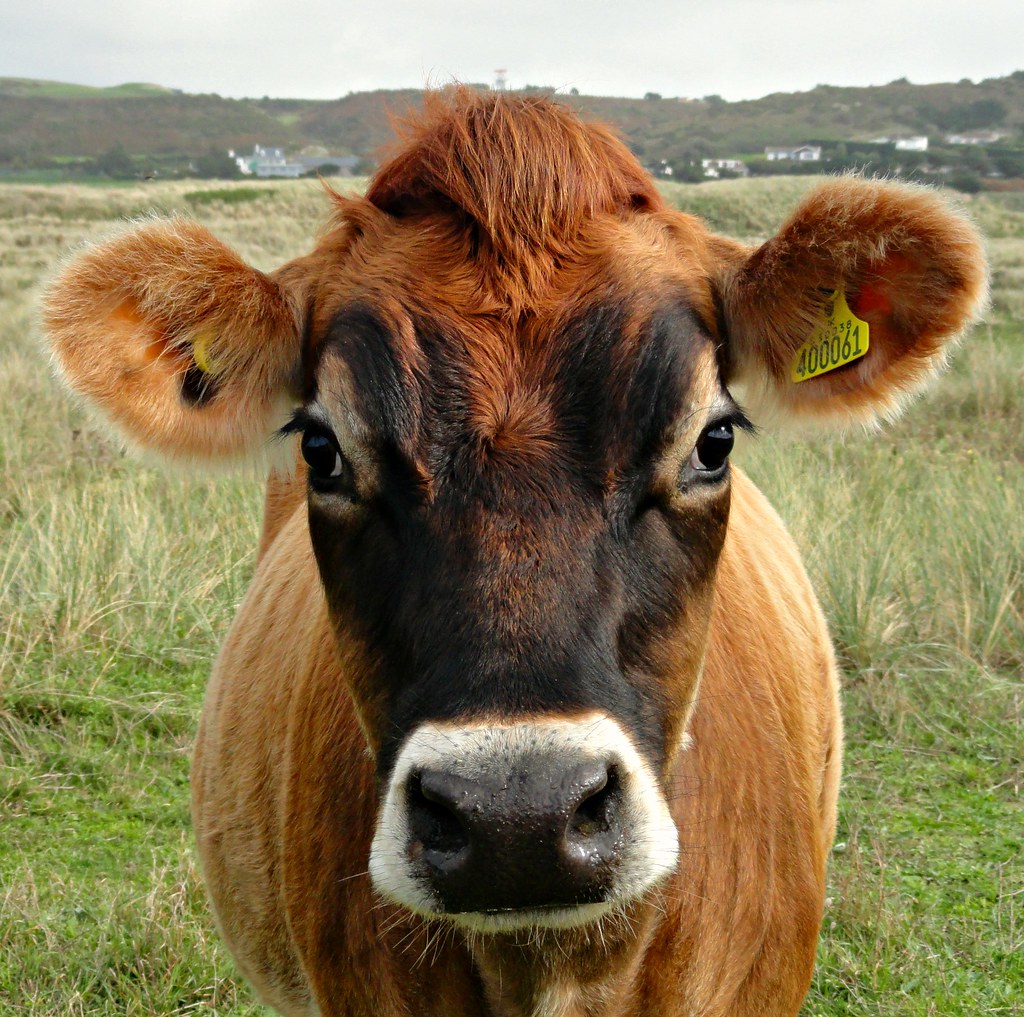The images in Martin Parr’s ‘Common Sense’ are very energetic and colourful. Parr uses the same language of advertising through the bright vibrancy of the images which makes them stand out and entice the viewer in. Parr however produces his own satirical twist on this, through evoking this style not to depict beauty but instead a more vulgar aspect of advertised imaging. In doing so Parr forces the viewer to question the manipulative effect of advertised images

SPECIFICATION
For my exam project I am going to explore local food produce in Jersey. I will consider the three main produce which Jersey is most associated with; potatoes (Jersey Royals), fish and diary.
| RE-CAP
|
As this project began I started to look into the themes of Propaganda, focusing particularly on Soviet Union propaganda techniques, and exploring how the Communist regime used various propaganda techniques to entice and draw people into their ideological cause. I also looked at the artistic side of this, evaluating how art has changed and advanced rapidly during this period, linking such findings to how this affected advertising. The main Soviet Propaganda artists which I looked at from this period were
- Dziga Vertov: filmmaker known for his film “Man with a Movie Camera”
- Alexander Rodchenko: constructivism
- Varvara Stepanova: constructivism/photo-montages
This change lead to new and emerging techniques such as photo-montages; a greater distribution through the formation of mass production of media outlets and the general emphasis on producing more visual and attractive art. I explored the context of all of these themes in good detail, producing a fairly well rounded summary of what propaganda is; the intent of it; and the effect it has on people.

|
| DEVELOPING MY IDEA
|
After gaining some contextual understanding of the history and development of advertising/propaganda in photography, I began to look at how these past techniques, concepts and ideas have shaped and influenced the advertising and propaganda of today, as well as how contemporary photographers have addressed and responded to this idea. In doing so I noticed one theme which linked all forms of propaganda and advertising together – the concept of ‘consumerism’. All propaganda, whether it be of political or commercial influence is inherently linked by the idea of persuading someone to invest into a cause with the promise that it will in some way affect that persons life in a positive way. In this sense propaganda usually finds the balance between having an emotional affect on a consumer …… in a way which leaves a positive message that encourages them to further explore and be willing to invest. In other words it plays on good feelings and tries to get the consumer to feel confident and assured to invest in that product. |
| WHAT IS MY CONCEPT? |
Using the influence of two photographers, Martin Parr and Henk Wildschut, I want to link two different aspects of food production together: production vs. selling.
I will go to both shops as well as areas that food is produced, producing images relating to both sides of this industry. I will try to remain objective in my photographic approach, photographing merely what I see, oppose to manipulating or staging any of the images.
This project will be an observational account of my findings, using a documentary style. Over the course of this project I want to be able to address the question: “is the way food is advertised really truthful?”. My suspicions would be that this is not entirely the case and I believe photography would be a very good way of finding strong and balanced evidence for this case.

|
| STAGE ONE
|
What?
My images will be linked to two sides of advertising; the first side will look at the ‘fantasy’ of a product which is created through deliberately deceptive photographic techniques which are used in advertising. The images I will create will be similar to classic advertising, but have a sense of irony to them
Linking to my study of advertising, I will investigate how advertising is connected very much to the theme of ‘fantasy’, an idealistic view of a product which does not necessarily reflect reality. I will therefore produce a series of image which play on the visual language of advertising, using the distinctive style of Martin Parr as a point of reference.
How?
I will visit local food retailers and shopkeepers and ask to photograph the food produce displayed on their shelves, get portraits of the shopkeepers and photograph general food items. Over the course of this process I hope to gain a body of images relating how the retail/selling side of local produce; who is involved and what is displayed.
I am going to try the copy the photographic style of Martin Parr, based on his series of images, entitled ‘Common Sense’. In this series Parr evokes a satirical twist on the theme of advertising, producing images which are deliberately designed to be in some cases vulgar and grotesque, a complete contradiction of classic ‘promotional images’.
I will also make a few experimental images whereby I copy standard photographic techniques in advertising to make the images more visually pleasing and attractive. To do so I will set up a mini photo studio in my kitchen, and all of the images will be the same in the sense that they will be carefully composed in a controlled environment. Although similar to my Parr inspired images, they will nevertheless evoke a more typical style and importantly mood, associated with visual advertising.
Why?
I am doing this because I want to respond in a direct way to the way in which images are advertised, in the process placing my own twist on this concept. I will be acknowledging the methods of advertising in a way that isn’t necessarily that complimentary.



|
| STAGE TWO |
What?
In the second stage of my photographic study I will turn the attractive, colourful and enticing visual language of advertising on its head, creating images that look at food production, oppose to the advertising side.
How?
I will copy the style and theme of Henk Wildschut in his photo-series ‘food’. In this series Wildschut explores through his direct and simplistic documentary style, the everyday occurrence and happenings of a meat production factory. It provides a very realistic insight into the way meat is mass produced and processed. It provides a general overview of all of the occurrences, a narrative which explores themes in short, sharp bursts.
Oppose to stage one where I will look at and respond the methods/style of advertising, I will reserve idea by exploring the ‘truth’ of how these products are made, going into factories, farms and production areas where all three of these food products go from their most basic form to appearing on the shelves; ready to be advertised.
I will visit farmers on their farms, fisherman at work etc. … I will follow the journey from how a product is sourced to when it appears on the shelf
Why?
Throughout this process I hope to challenge to the extent of ‘truth’ behind how something is advertised by comparing how it appears after its completion to the processes and appearance of it beforehand.
This second stage I hope will add an extra dimension to my work, as it will give my visual story more depth, as well as a point of contrast.



|
| Overall |
I am hoping that this project will be exciting and interesting to complete, and that I will find a lot out about the way our local food is produced.
I plan to visit as many places as possible over the time I have to complete this project to gain a strong visual body of work as well as a greater personal understanding of what it is reality of how Jersey’s well renowned products are done.
Leading on from my last point, as the products I am investigating are fundamentally a part of Jersey’s heritage and historical culture, my work will subsequently be very much be an investigation in the key values of island life, accepting that although times have changed, there will always be a sense of pride for Jersey’s unique products such as diary, fish and potatoes. I hope to explore this sense of pride in my images, or at least explore whether such themes exist in a modern island dominated by business in large finance centres, a far cry from an island previously dominated by farming and agriculture for hundreds of years.

|
Just another Hautlieu Creative site










